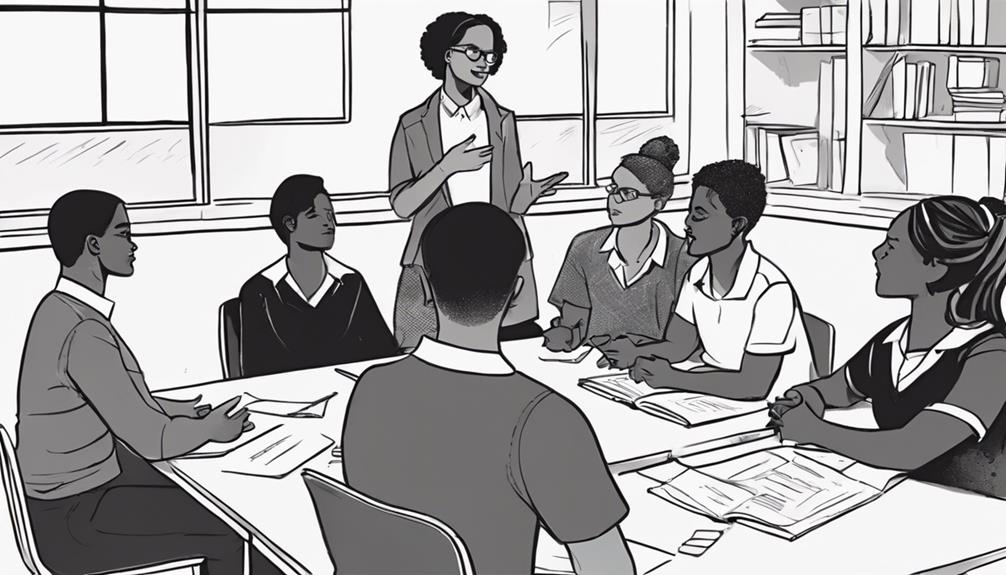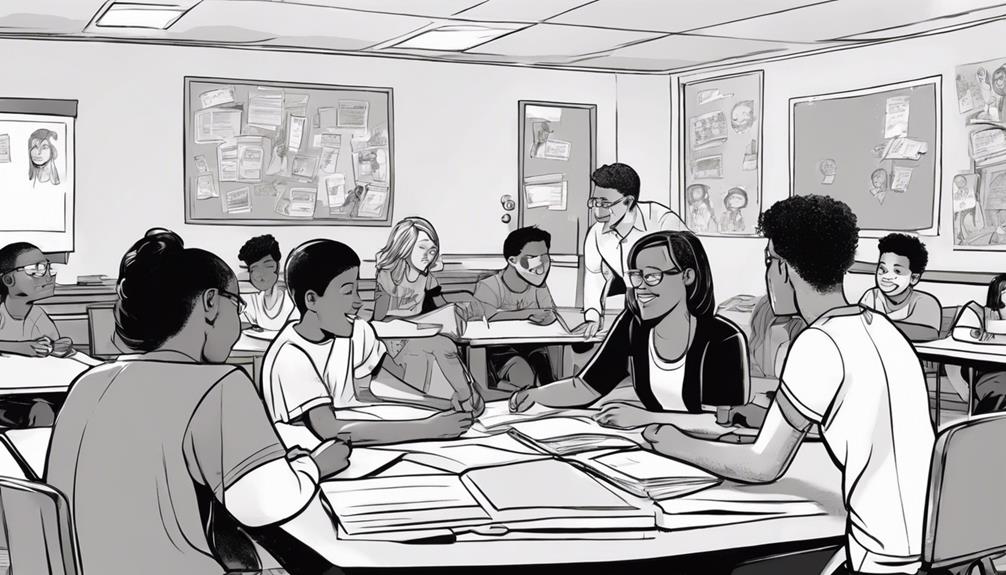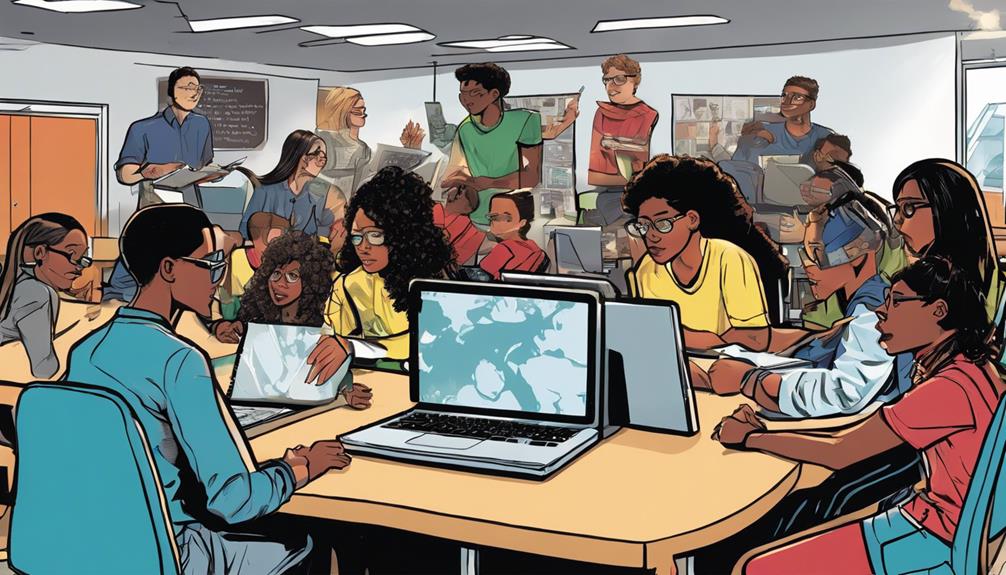Reveal the secrets to mastering classroom leadership by delving into key strategies essential for success. Immerse yourself in a world of essential leadership skills, techniques for nurturing student relationships, integrating technology effectively, fostering emotional intelligence, and boosting student engagement. By honing these skills, educators can effectively communicate, adapt, problem-solve, inspire, and create supportive atmospheres for students. Active listening, personalized feedback, and consistent communication are just a few techniques to enhance student-teacher relationships. Embrace innovation, cater to diverse learning styles, and stimulate curiosity to create an engaging learning environment where students thrive. Discover the path to becoming a classroom leader today!
Key Takeaways
- Prioritize effective communication and adaptability.
- Foster a supportive atmosphere for students and staff.
- Implement technology for dynamic and engaging learning environments.
- Cultivate emotional intelligence to enhance teacher-student relationships.
- Inspire student engagement through innovative instructional strategies.
Essential Leadership Skills in Education

Effective leadership skills are paramount in the field of education for fostering a positive and impactful learning environment. As educators, possessing strong leadership qualities is essential for guiding students towards success. These skills include effective communication, adaptability, problem-solving abilities, and the capacity to inspire and motivate others.
By demonstrating leadership in the classroom, teachers can create a supportive atmosphere that encourages student engagement and academic growth. Additionally, leadership skills enable educators to effectively manage classroom dynamics, cultivate a culture of respect and collaboration, and promote a sense of community among students.
Techniques for Building Student Relationships

In the field of education, establishing strong student relationships is fundamental for fostering a supportive and engaging learning environment. Building these relationships goes beyond the classroom walls and can have a substantial impact on student success.
Here are three key techniques for building strong student relationships:
- Active Listening: By actively listening to students' thoughts, concerns, and ideas, educators show that they value and respect their input.
- Personalized Feedback: Providing individualized feedback tailored to each student's strengths and areas for improvement demonstrates care and attention to their progress.
- Consistent Communication: Maintaining open lines of communication through regular check-ins, updates on class progress, and availability for questions helps students feel supported and engaged in their learning journey.
Implementing Technology in Classroom Leadership

Utilizing technology in classroom leadership enhances educators' ability to engage, motivate, and inspire students towards academic success. By incorporating digital tools and resources, teachers can create interactive and dynamic learning environments that cater to diverse learning styles.
From interactive whiteboards for visual learners to educational apps for hands-on engagement, technology offers a plethora of opportunities to enhance classroom leadership. Virtual field trips, online collaboration platforms, and multimedia presentations can all enrich the educational experience and make learning more exciting and accessible.
Additionally, technology enables teachers to provide instant feedback, track student progress, and personalize instruction, ultimately fostering a more efficient and effective teaching approach. Embracing technology in classroom leadership opens doors to endless possibilities for innovation and student growth.
Cultivating Emotional Intelligence for Teachers

Developing emotional intelligence is an essential aspect of professional growth for teachers aiming to improve their classroom leadership skills. Cultivating emotional intelligence involves understanding and managing emotions effectively, which can greatly impact teacher-student relationships and overall classroom dynamics.
To enhance emotional intelligence, teachers can:
- Practice self-awareness to recognize their own emotions and reactions.
- Develop empathy to understand and connect with students on a deeper level.
- Utilize emotional regulation techniques to maintain composure and make informed decisions in challenging situations.
Strategies for Inspiring Student Engagement

Moreover, enhancing student engagement in the classroom involves implementing innovative instructional approaches that stimulate curiosity and active participation among learners.
One effective strategy is to incorporate interactive activities that require student collaboration, such as group projects or discussions. These activities not only encourage students to engage with the material but also foster teamwork and communication skills.
Additionally, integrating technology into lessons can capture students' interest and make learning more interactive and dynamic. By using multimedia tools, educational apps, or online resources, educators can create a more engaging learning environment that resonates with the tech-savvy generation.
Moreover, providing real-world connections to the curriculum can inspire students by showing them the practical applications of what they are learning.
Frequently Asked Questions
How Can Teachers Handle Difficult Parents Effectively?
Teachers can handle difficult parents effectively by maintaining open communication, actively listening to concerns, showing empathy, and seeking solutions collaboratively. Setting clear boundaries, documenting interactions, and involving administrators when necessary can also help address challenges constructively.
What Are Effective Ways to Manage Teacher Burnout?
Teacher burnout, a pervasive issue, demands immediate attention. To manage it effectively, prioritize self-care, set boundaries, seek support, and rest. Without proactive measures, burnout jeopardizes teacher well-being and impacts student success.
How Can Teachers Maintain Work-Life Balance?
Teachers can maintain work-life balance by setting boundaries, prioritizing tasks, delegating when possible, practicing self-care, and seeking support from colleagues or mentors. Balancing workload with personal time is essential for overall well-being and effectiveness in the classroom.
What Strategies Can Help Teachers Deal With Challenging Students?
Teachers can effectively deal with challenging students by implementing strategies such as building strong relationships, utilizing positive reinforcement, setting clear expectations, providing consistent support, and employing behavior management techniques. These approaches foster a conducive learning environment.
How Can Teachers Foster a Positive School Culture?
Teachers can foster a positive school culture by promoting respect, inclusivity, and collaboration. Encouraging open communication, setting clear expectations, and recognizing student diversity are key. Building a sense of community, celebrating achievements, and prioritizing student well-being are essential for creating a harmonious learning environment.
Conclusion
Begin a journey of discovery and growth as you explore the world of mastering classroom leadership.
Reveal the key strategies that will empower you to create a positive and inspiring learning environment for your students.
With essential skills, techniques for building relationships, implementing technology, cultivating emotional intelligence, and inspiring engagement, you'll be equipped to lead with confidence and make a lasting impact on the lives of those you teach.
Let's unleash the potential within and soar to new heights together!










